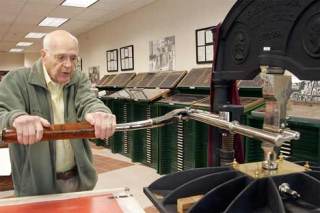The job would normally take two people, but John DeNure, curator for the Thorniley Collection at West Coast Paper, dutifully shows the 13 steps it would take to run the giant 1850s-era printing press in the corner of one museum.
The press, made by R. Hoe and Co. from New York is the oldest in the building.
The paper must be set in a guide, the individual blocks of text must be checked and painted with ink and the crank must be pulled back, pressing the paper on to the inked blocks.
Normally a “puller” and a “beater” would work in tandem to produce about 240 impressions an hour, which is not a small number after watching DeNure go through the series of moves necessary to create a single page.
“That’s a lot,” he says, releasing the crank.
In today’s day and age of instant printing and laser color, it’s hard to imagine cranking out each individual sheet by hand, but the Thorniley Collection is dedicated to preserving just such a memory and a time when each individual letter had to be put into place by hand.
Named for the collection’s original owner, the collection, which is housed at West Coast Paper’s facility on 64th Avenue South, is today managed by DeNure.
Purchased in 1975 and moved to West Coast Paper in 1977, DeNure has been the curator of the museum since, though he has retired three times.
“Nobody else had any experience running a letter press except myself,” says DeNure, 90. “That’s how I got the job.”
A salesman by trade, DeNure has been a hobby printer for 40 years, after learning to set type by talking to every printer in town.
He was at the house of an acquaintance and saw in the man’s home a “parlor press,” a small printing press, like the one that still sits in the museum. The gentleman offered the press to DeNure, who took it home and began learning how to set type.
“When I started I didn’t know anything,” he says, adding that he “got hung up on it” quickly.
“I learned to set type right well,” he says.
He still uses his press, doing small batches of invitations and other small items for friends.
Along with several presses, the museum also boasts a collection of more than 1,500 hand-carved fonts in both wooden and metal blocks, spread out in cases that line the walls and are stashed underneath tables throughout the room.
Most are from the 1800s, but DeNure says there is one as old as 1690.
There are fonts of all different types, from classic-style newspaper fonts to old West-looking fonts to script fonts, which are DeNure’s favorite.
In fact, his favorite fonts are the kind they used to make Bibles, generally with very ornate first letters.
But along with fonts and presses, the museum houses old bookbinding equipment and other devices from the era.
So far, during his tenure, there have been visitors to the museum from 14 countries and 20 different states.
Which is the way DeNure wants it as he considers the museum not only for the community, but for all of humanity, like the uniting force that movable type has been since popularized by Johannes Gutenberg in the 1500s (his picture graces the museum, though DeNure doesn’t necessarily think he invented the process, only helped to perfect it).
“When I come in here, I see that whole picture,” he says. “It isn’t just us here … it’s all of civilization.”
THE THORNILEY COLLECTION
The Thorniley Collection is located at West Coast Paper, 23200 64th Ave. S. in Kent. The museum is open by appointment only. To schedule a visit, call 253-850-1800.
Talk to us
Please share your story tips by emailing editor@kentreporter.com.
To share your opinion for publication, submit a letter through our website https://www.kentreporter.com/submit-letter/. Include your name, address and daytime phone number. (We’ll only publish your name and hometown.) Please keep letters to 300 words or less.

